Abstract
In China’s Yangtze River Basin, systematic waterway improvement and dredging maintenance have increased the waterway water depth compared with that before the implementation of the Three Gorges Project. Although the water depth of the middle section increased from 2.9 m in 2002 to 4.2 m in 2021, it remains less than 6.0 m in the lower section and 4.5 m in the Three Gorges Reservoir area. This study explores the Chenglingji—Wuhan reaches in the middle section of the Yangtze River, using hydrological data from 1954 to 2021 and topographic data from 2002 to 2021 to analyze river channel scouring or deposition characteristics, verify the waterway scale with a multi-scale width of 4.5 m water depth, and propose waterway management countermeasures. After the implementation of the Three Gorges Project, the Chenglingji—Wuhan reaches were scouring using a low-flow channel (94.95%), thereby facilitating waterway depth improvement. A serious obstruction area was located in the branching channel, and an unstable relationship between the boundary of the continental bank and the branching channel was found to be the main factor hindering navigation, with a water depth below 4.5 m. The Chenglingji—Wuhan reaches waterway water depth has been raised from 2.9 m in 2003 to 4.2 m; it can be raised to 4.5 m through waterway scale improvement. This study explains the navigation obstruction characteristics of alluvial waterways, which has important reference value for waterway scale improvement and planning, and the efficient utilization of deep-water resources.
1. Introduction
In recent decades, extreme natural conditions and human activities have severely affected the rates of riverbed scouring or deposition and water level adjustment [1], and the construction of reservoirs or dams has changed the original runoff–sediment–riverbed dynamic equilibrium [2,3]. Downstream of the dam, strong riverbed scouring and water level rise and fall occur to adapt to changes in runoff and decreases in sediment amount [3,4,5]. As a significant economic function of rivers, increasing waterway water depth is crucial for improving the economic benefits of shipping; however, this is constrained by an uneven riverbed scouring [6], continental bank boundaries [7,8], and branch channel divergence relationships [9,10], as well as by the need to consider additional aspects such as technical difficulties in waterway remediation [11], dredging, the ecological environment, and biological habitats.
Since 2003, the water depth in the middle-lower reaches of the Yangtze River (Changjiang River) channel has been significantly increasing by riverbed scouring, waterway improvement, and river potential control following the implementation of the Three Gorges Project [5,11,12]. For example, the water depths in the Jingjiang reaches [11], the Wuhan—Anqing reaches [11], and the Nanjing—Yangtze Estuary [10,13] have increased from 2.9 to 3.7 m, 4 to 6 m, and 8 to 12.5 m, respectively. The middle-lower reaches of the Yangtze River, known as the “Golden Waterway” [14,15], are crucial for the economic and social development of the basin. As of December 2022, the Yangtze River cargo volume of 32.6 × 108 t/y [16] has been ranked first in the world for inland waterway navigation. After the implementation of a large reservoir in the basin, the river channel downstream of the dam exhibited significant scouring and deep cuts. Where the average riverbed scouring depth was greater than the decrease in water level, the water depth of the waterway increased; otherwise, it decreased. For instance, the designed minimum navigable water level decreased in the middle reach of the Yangtze River near the Three Gorges Dam (approximately 400 km), which was not conducive to an increase in waterway water depth [17]. The minimum flow of the Three Gorges Reservoir discharge has been increasing [11], which directly increases the waterway depth during the dry period and creates favorable conditions for waterway scale enhancement in the near-dam section of the sand and cobble riverbed [18] and the upper Jingjiang reaches [19,20]. During waterway water depth improvement, the downstream deep-water waterway gradually extends upstream. Because the water storage of the reservoir directly increases the waterway water depth, the water depth downstream of the dam does not connect the upstream reservoir area to the downstream deep-water waterway [5,11], which restricts the sustainable development of waterway resources in the basin. China’s 14th Five-Year Plan for the Development of a Modern Comprehensive Transportation System specifies that “the upstream part of the Yangtze River will actively promote the improvement of the key obstructed waterway in the Yibin—Chongqing reaches and the construction of the 4.5 m waterway in the Chongqing—Yichang reaches. In the middle section, the Yichang—Wuhan reaches of the waterway has improved in an orderly manner. We will steadily improve key waterways in the lower reach of the Anqing—Nanjing reaches and further improve the conditions of the deep-water (12.5 m) waterways below Nanjing” [21]. The implementation of systematic waterway improvement engineering is necessary to enhance the waterway scale and improve the navigation conditions. A systematic understanding of runoff and sediment conditions, geomorphological evolution processes, and trends is a prerequisite for the reasonable arrangement of waterway engineering and the determination of the main scale parameters. At present, the feasibility of the 4.5 m waterway water depth project is being tested for the Jingjiang reaches (Zhicheng—Chenglingji) in the middle sections of the Yangtze River. The 6-metre waterway improvement project for the Wuhan—Anqing reaches has been completed and accepted, while the waterway water depth for the Chenglingji—Wuhan reaches in the middle sections is only 4.2 m. Due to the lack of upstream and downstream water depth, the benefits of the golden waterway are restricted [11,19,20]. Therefore, taking the Chenglingji—Wuhan reaches in the middle sections of the Yangtze River as the object, it is necessary to further define the relationship between navigation obstruction, riverbed scouring and deposition, branch bifurcation ratio, and the morphology change in central bar and bank in the process of upgrading the waterway scale, so as to further support the improvement of comprehensive benefits of the “Golden Waterway” of the Yangtze River.
In this study, the Chenglingji—Wuhan reaches (the length of the river channel is 227.5 km) of the middle section of the Yangtze River were investigated to analyze waterway scouring or deposition characteristics using runoff and sediment data from 1954 to 2021 and topographic data from 2002 to 2021. Additionally, waterway verification was conducted at a water depth of 4.5 m and widths of 60, 150, and 200 m to propose management countermeasures for waterway scale enhancement.
2. Materials and Methods
2.1. Study Area
The Chenglingji—Wuhan reaches in the middle section of the Yangtze River are 227.5 km long (Figure 1); the Chenglingji—Panjiawan reaches (121.1 km) are a continuous coupled-joint branching channel. The Panjiawan—Shamaoshan reaches (74.4 km) are curved, and the Shamaoshan—Wuhan (Hankou) reaches are a straight branching channel of 33.0 km. The Chenglingji—Wuhan reaches have a sandy riverbed with hills on both banks forming nodes. The river channel morphology is basically stable, which also inhibits an evolutionary correlation between the upstream and downstream branching sections [22,23].
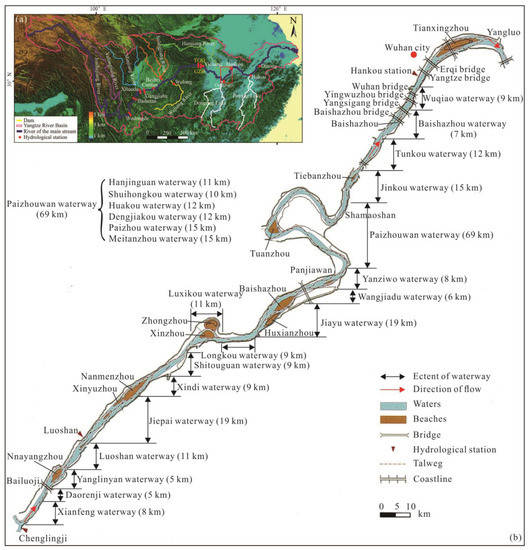
Figure 1.
Location map of the Chenglingji—Wuhan reaches in the middle reach of the Yangtze River. (a) Location of the study area; (b) waterway division map of the Chenglingji—Wuhan reaches.
2.2. Research Data and Methods
2.2.1. Research Data
Data related to the flow rate, sand transport rate, and water level at the Luoshan and Hankou hydrographic stations from 1954 to 2021 were collected from the Changjiang Hydrographic Bureau to analyze and study the changes in incoming runoff and sediment conditions in the reach. Acoustic Doppler Current Profilers (ADCPs) were used in velocity and flow testing; Differential Global Navigation Satellite System (DGNSS) positioning and Global Navigation Satellite System (GNSS) compass were used for track correction and bow correction. The ADCP current measuring system adopts RDI-BBADCP (Research Development International –Broad-band ADCP) series 300 kHz, 600 kz, and 1200 kz instruments, and the data acquisition software version is WinRiver-II 2.20/2.18. The sediment content of suspended mass was tested using the filtration–drying–weighing method, and a 1/10,000 electronic balance was used for weighing. Topographic data of the Chenglingji—Wuhan reaches from 2001 to 2021 were collected and measured using the laser method. The test scale was 1:10,000, the maximum transverse distance of the measured section is less than 50 m, the maximum longitudinal distance is less than 100 m, and data were obtained from the Changjiang Waterway Survey Center and the Changjiang Hydrographic Bureau (Table 1).

Table 1.
Data characteristics and sources.
2.2.2. Verification Method of Waterway Conditions
Navigational data include the water level H0 values corresponding to the position of a section and, usually, the water surface line along the river channel, with a 98% guarantee calculated using the synthetic duration curve method (Figure 2a). The difference between the water level from the navigational data and the elevation of the waterway bottom is equal to the water depth (h). The dimensions of a waterway include the water depth (H), width (B), bend radius (R), and navigation clearance height (Hmax). If the water depth corresponding to the actual lowest navigable water level (h) is less than the target navigation depth (H), a break will appear in the depth contour corresponding to H, a navigation obstacle because of the insufficient water depth (Figure 2b). If a location on the waterway has a h greater than H, the depth contour at H is not interrupted but has a width less than B; the location is a navigation obstacle caused by an insufficient navigable width. Similarly, if R is too small for a safe passage, route adjustments may lead to insufficient waterway width and/or depth.
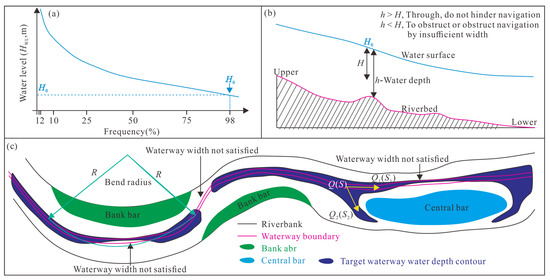
Figure 2.
Calculation of waterway depth and ratios of runoff and sediment. (a) Determination of the lowest navigable water level; (b) waterway water depth calculation; (c) calculation of navigation obstruction ratios of runoff and sediment.
Velocity measurements and flow calculations were conducted using boat-mounted Acoustic Doppler Current Profilers (ADCPs), with the horizontal measurement interval being 100 m. The calculation equations for cross-sectional flow were as follows:
where QADCP is the flow rate (unit: m3/s), S is the sectional area of the river (unit: m2), u is the flow vector at a particular point in the river section, ξ is the unit normal vector on the track of the measuring ship, ds is the microelement area on the river section, Vb is the velocity of the measuring ship, dz is the z degree of the vertical microelement area, z was calculated from the riverbed elevation (unit: m), and dt is the temporal microelement.
The sections along the navigation track were discretized into m micro-sections, and the flow was calculated as follows:
where T is the navigation time for the cross-section (unit: h), Hi is the water depth at micro-section i (unit: m), m is the total number of micro-sections within the river section, Δt is the average step size of the measurement time corresponding to the micro-section (unit: s), and k is the vertical unit vector.
The split ratios of water ratios (Figure 2c) were calculated as follows: First, the total inflow of the braided reach Q was obtained. If the runoff flowing into each branch is Qi (i = 1, 2,…, n, where n is the number of branches), the split ratios of water distribution ratios ηi of each branch are given by the following equation:
2.2.3. Calculation Method of the Navigation Scale
The Yangtze River Main Line Navigation Standards (JTS180-4-2015) recommend that the representative ship types of the Chenglingji—Wuhan reaches are a 5000-ton cargo ship and a 350 TEU (Twenty-foot Equivalent Unit) container ship, whose design draft water depth is 4.5 m; considering the rich water depth of 0.5 m, the actual ship draft water depth is 4.5 m. Based on the demand of the waterway and the actual size of the representative ship types, the minimum navigational width required for single-ship double-line navigation is 83–90 m. Additionally, the Yangtze River Main Line Navigation Standards propose to determine the width of the I-5 grade waterway by using the waterway grade I-2 representative ship type (316 × 48.6 × 3.5 m) in the “Inner River Navigation Standard,” and the minimum navigational width for two-lane navigation is 195 m. Combined with the actual situation of the waterway, three levels of waterway width are established in the 4.5 m navigational scale of the Chenglingji—Wuhan reaches. The first level meets the single-vessel two-way passage (60 m wide), the second level meets the single-vessel and fleet meeting the vessel two-way passage (150 m wide), and the third level meets the fleet two-way passage (200 m wide) requirements (Table 2).

Table 2.
The design representing the ship shape.
2.2.4. Calculation of Riverbed Scouring or Deposition Volumes
A multi-beam sounder was used to measure the riverbed topography, and the scale of the measurement was 1:10,000. The proportion of the encrypted measurement of the waterway regulation building area was 1:2000, and the measurement error was less than 10 cm. The low-flow, bankfull, and flood channels of the Chenglingji—Wuhan reaches corresponding to the flow rates of 10,000, 30,000, and 45,000 m3/s were defined as the riverbeds below the runoff surface line at the Datong hydrographic station. The topography was calculated using the relationship between water levels and flows as in October 2001. Among them, the low-flow channel was a deep channel, the low banks were located between the low-flow and bankfull channels, and the high banks were located between the bankfull and flood channels. For the process of calculating the riverbed scouring or deposition using the section method, see Yang et al. (2022) [6]. The volumes of the bank and deep channel are calculated using the grid method. A triangular grid is used to dissect the computational domain, and the grid density is the same as the density of the measured terrain scatter points to ensure the consistency of the calculation results with the measured results (Figure 3). After dissection, each triangular cell forms a wedge, and the cross-sections of the isobaths at different depths and the bank are the straight sections of the wedge.
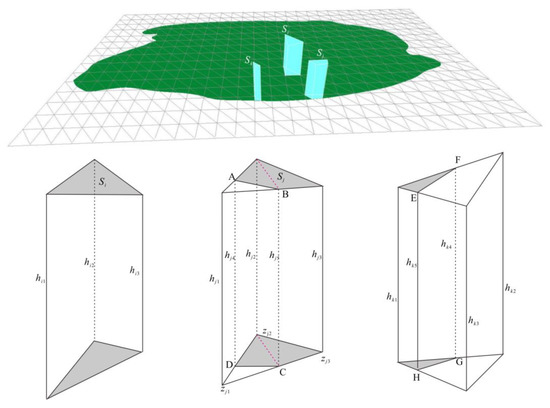
Figure 3.
Calculation of the volume of the bank and river channel.
- (1)
- Case 1: Internal grid of the computational domainwhere Vin is the volume of the triangular cells inside the computational domain, m is the total number of cells inside the computational domain, hi1, hi2, and hi3, are the distances from the cross-section to the riverbed at the grid nodes, and Si is the area of the triangular cells.
- (2)
- Case 2: Boundary grid of the computational domain
Quadrilateral (hj4 = 0, hj5 = 0)
where Vout-qua is the volume of the quadrilateral cells at the boundary of the computational domain, n is the total number of quadrilateral cells at the boundary of the computational domain, hj2 and hj3 are the distances from the cross-section to the riverbed at the grid nodes at the boundary of the computational domain, and Sj = Sj1 + Sj2 and Sj are the areas of the shaded quadrilateral in the boundary cells of the computational domain.
3. Research Process
3.1. Runoff and Sediment Conditions
The runoff volumes at Luoshan hydrographic station (Hankou hydrographic station) from 1954 to 1980, 1981 to 2002, and 2003 to 2021 were 6414 × 108 m3 (7046 × 108 m3), 6516 × 108 m3 (7228 × 108 m3), and 6255 × 108 m3 (6977 × 108 m3), with reductions of 4.01% (3.47%) and 3.18% (2.11%) from 2003 to 2021 compared to 1980–2002 and 1954–2002, after the start of the Three Gorges Project (Figure 4, Table 3). The amount of sediment during 1954–1980, 1981–2002, and 2003–2021 at Lusohan hydrographic station (Hankou hydrographic station) was 4.25 × 108 t (4.29 × 108 t), 3.90 × 108 m3 (3.60 × 108 t), and 0.83 × 108 t (0.95 × 108 t), respectively. The reductions were 78.72% (73.61%) and 79.71% (79.31%) from 1980 to 2002 and 1954 to 2002, respectively, after the start of the Three Gorges Project.
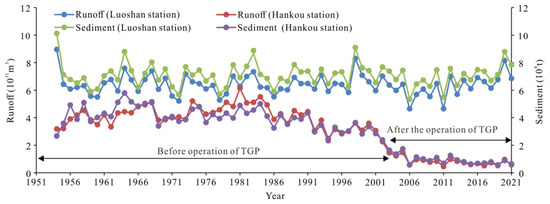
Figure 4.
Variations in runoff and sediment conditions at Luoshan and Hankou hydrographic stations.

Table 3.
Runoff and sediment characteristics at Luoshan and Hankou hydrographic stations.
3.2. Changes in Riverbed Scouring or Deposition
After the start of the Three Gorges Project, the incoming sediment in the upstream basin was considerably reduced, and a scouring trend was observed in the Chenglingji—Wuhan reaches (Figure 5). From 2001 to 2021, the riverbed scouring volumes of the low-flow and the bankfull channels in the Chenglingji—Wuhan reaches were 6.65 × 108 m3 and 6.93 × 108 m3, respectively, and the scouring volume of the low-flow channel accounted for 94.95% of the bankfull channel. The elevation points of the thalweg were lower in November 2020 compared with November 2003. After the start of the Three Gorges Project, the overall scouring and undercutting trend in the Chenglingji—Wuhan reaches was conducive to the improvement of the channel bathymetry. Low bank scouring (bank between the bankfull and low-flow channels) since 2016, accounting for 5.05% of the total scouring volume, mainly corresponds to the scouring of the head of the continental body and the waterward area of the upper reach of the side bank; the impact of continental bank scouring on the boundary conditions of the river channel should be considered.
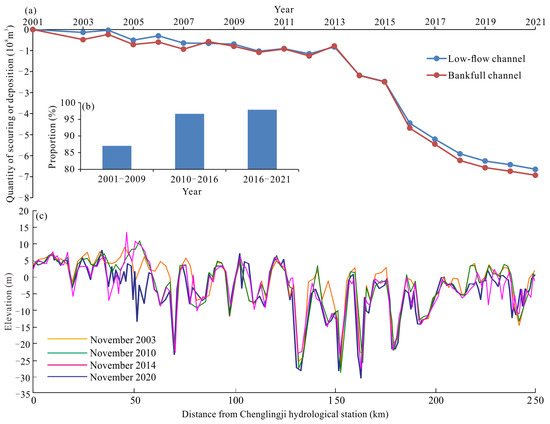
Figure 5.
Characteristics of riverbed scouring or deposition in the Chenglingji—Wuhan reaches. (a) Amount of riverbed scouring or deposition; (b) proportion of low-flow channel scouring; and (c) thalweg of the riverbed.
3.3. Waterway Condition
Based on the measured topography from 2016 to 2021, the selected water depth was 4.5 m, and the widths were 60, 150, and 200 m for waterway scale verification (Figure 6a). The verification results show that most of the water depth conditions from the Chenglingji—Wuhan reaches are good, and the minimum water depth satisfies the 4.5 m condition. The last five years or the last five topographies show that the waterway scale of a total of five waterways, namely Jiepai (Figure 6b), Longkou (Figure 6c), Jiayu (Figure 5d), Yanziwo (Figure 6e), and Wuqiao (Figure 6f), cannot satisfy the requirements of 4.5 × 200 m and 4.5 × 150 m.
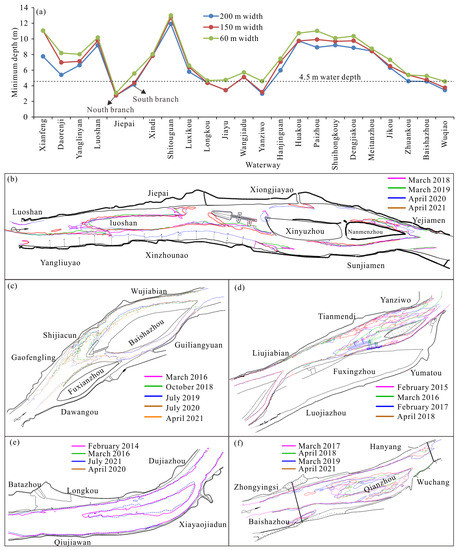
Figure 6.
Changes in the 4.5 m depth waterway conditions. (a) Changes in the waterway conditions; (b) Jiepai waterway; (c) Jiayu waterway; (d) Yanziwo waterway; (e) Longkou waterway; and (f) Wuqiao waterway.
- (1)
- Jiepai waterway: in the south branch waterway, the water depths for 200, 150, and 60 m navigational widths under the driest conditions were 4.17–5.37 m, 4.37–6.37 m, and 5.57–7.17 m, respectively. The waterway scale met the requirement of 4.5 × 60 m, but for a few years, it did not meet the requirements of 4.5 × 200 m and 4.5 × 150 m. In the north branch waterway, the water depths under the driest water level for 200, 150, and 60 m navigational widths were 2.77–4.37 m, 2.77–4.77 m, and 3.07–4.97 m, respectively. The waterway scale did not meet the requirement of 4.5 × 200 m; for a few years, it was below 4.5 × 150 m and 4.5 × 60 m.
- (2)
- Longkou waterway: at the mouth of the main river channel in the left waterway, the water depths for 200, 150, and 60 m navigational widths under the driest conditions were 4.37–6.17 m, 4.37–6.67 m, and 4.67–8.07 m, respectively. The waterway scale met the requirement of 4.5 × 60 m, and for a few years, it was below 4.5 × 200 m and 4.5 × 150 m.
- (3)
- Jiayu waterway: the water depths in the main waterway of the left branch at 200, 150, and 60 m navigation widths in the driest conditions were 3.44–5.74 m, 3.44–5.84 m, and 4.74–5.94 m, respectively, which did not meet the requirements of 4.5 × 200 m and 4.5 × 150 m for a few years.
- (4)
- Yanziwo waterway: the water depths in the main waterway of the left branch at 200, 150, and 60 m navigation widths under the driest conditions were 2.99–7.59 m, 3.19–7.89 m, and 4.59–8.19 m, respectively, which did not meet the requirements of 4.5 × 200 m and 4.5 × 150 m for certain years.
- (5)
- Wuqiao waterway: the water depths in the main waterway of the left branch at 200, 150, and 60 m navigational widths under the driest conditions were 3.45–6.95 m, 3.75–7.55 m, and 4.55–7.95 m, respectively; they did not meet the requirements of 4.5 × 200 m and 4.5 × 150 m for certain years.
3.4. Variation in Minimum Water Depth in the Design Navigation Waterway
Based on survey maps from 2016, the waterway conditions of the Chenglingji—Wuhan reaches were verified, and five waterways, namely Jiepai, Longkou, Jiayu, Yanziwo, and Wuqiao, did not meet the requirements (Table 4).

Table 4.
Minimum water depths at different waterway widths.
4. Results
Waterways with water depths of less than 4.5 m were analyzed from the perspective of navigation obstruction in Jiepai, Longkou, Jiayu, Yanziwo, and Wuqiao. The analysis was performed in terms of the differences in riverbed scouring or deposition, the morphology of continental bank, and the relationship between branching channels.
4.1. Obstructive Features in the Upgraded Scale of the Jiepai Waterway
The Jiepai waterway is a smooth and straight branching type waterway. In the past, the area around Guhuazhou experienced periodic uplift and downward shift, resulting in a shallow depth channel and obstructed navigation [24]. In 1994 and 2012, a comprehensive management project of the Jiepai waterway and the second phase of the waterway improvement of the Jiepai waterway were implemented, and the maintenance water depth was raised to 4.2 m during the dry period, starting in January 2019. In March 2017, the Luoshan side bank shallow bale appeared at the inlet of the south channel, and the width of the 4.5 m channel was less than 80 m by March 2018. The width of the 4.5 m channel was less than 50 m in March 2019, and dredging maintenance measures were taken to guarantee smooth passage during the dry periods in 2019 and 2020.
4.1.1. Riverbed Scouring and Deposition
From February 2012 to April 2020, the head scouring of the Luoshan central bar was 1–2 m, and the tail deposition was more than 3 m. The left groove exhibited scouring development, and the right groove inlet to the middle-upper sections deposition was 2–3 m (Figure 7a). The left waterway of the heart bank of Luoshan was scouring attitude along the left channel, and the outlet area was scouring depth of 3.0 m. Under the action of waterway management engineering, the silt level of the low bank surface increased by 3 m from February 2012 to April 2020, and the brush depth of the entrance of the right channel in the main river channel was 2–3 m. The backwaters of the Xinyuzhou branch were left and right backwaters. The maximum backwater depth of the left backwater at and inside the inlet was 5 m, whereas the backwater depth of the right backwater was 3 m.
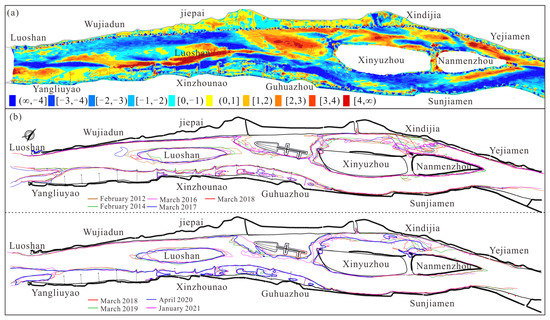
Figure 7.
Changes in riverbed scouring or deposition and bank morphology in the Jiepai waterway. (a) Distribution of riverbed scouring or deposition; and (b) change in the 0 m isobath.
4.1.2. Morphology of the Continental Bank
The location of the Luoshan central bar core bank was state, with a cumulative setback of 1000 m and a 25% reduction in area from 2018 to 2021 (Figure 7b). The constructed waterway improvement project stabilized the location of the right bank and the head of the Xinyuzhou central bar, with a setback of 70 m from 2018 to 2021 from the 0 m line at the head of the Xinyuzhou central bar.
4.1.3. Branch Channel Diversion Relationship
Since 2011, the diversion relationship between the two channels of the Luoshan and Xinyuzhou branches has been stable, and the south branch diversion ratio was 38.4% in February 2018 because of the development of the left channel of Xinyuzhou (Table 5). The north branch diversion ratio of Xinyuzhou showed a decreasing trend, with a 12% decrease in flow and a 20% decrease in the diversion ratio in August 2014 compared to August 2012. The south branch diversion ratio was 17.6% during the flood season in March 2018.

Table 5.
Boundary waterway branching channel diversion relationship.
In summary, the analysis shows that the scouring of the head of the Luoshan bank in the Luoshan waterway and the left channel scouring right channel deposition decreased the right branch diversion ratio, causing the water depth of the right branch inlet to be less than 4.5 m. The deposition of the left branch of the Xinyuzhou central bar–right branch scouring reduced the left branch diversion ratio, and the water depth of the left branch was less than 4.5 m, making it difficult to realize the double channel–double branch 4.5 m penetration.
4.2. Obstructive Features in the Upgraded Channel Scale of the Longkou Waterway
The Longkou waterway is a slightly curved and relaxed river controlled by an outlet islet. The relaxation of the river type and the picking up of the flow by the islet at the outlet cause the flow velocity at the relaxation to slow down and the hydrodynamic axis to turn left; the left channel of the heart bank is prone to forming an obstructive shallow point.
4.2.1. Riverbed Scouring or Deposition
From February 2014 to April 2020, the riverbed scouring and bank deposition in the Longkou waterway, the upstream Luxikou waterway channel into the Longkou waterway confluence, reached a deposition thickness of 1–2 m (Figure 8a), and the extent of scouring in the right bank was 3 m. The Huangsiwan—Qiujiawan reaches had a left channel maximum scouring depth of 3 m and a right-side maximum deposition thickness of 3 m. The Qiujiawan—Shangyaojiadun reaches showed left scouring and right deposition of 1–2 m. In the Shangyaojiadun—Shiji reaches, the heart bank showed scouring of 1–2 m, the left channel of the heart bank was silted, and the right river channel showed scouring of 1–3 m.
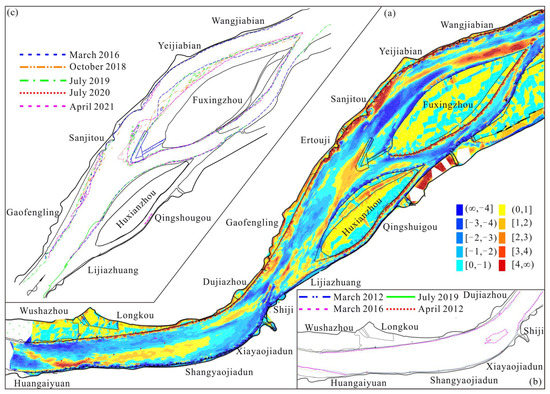
Figure 8.
Changes in riverbed scouring or deposition and continental bank morphology in the Longkou—Jiaoyu reaches. (a) Distribution of riverbed scouring or deposition; and (b,c) changes in the 0 m isobath.
4.2.2. Morphology of the Continental Bank
From February 2014 to April 2020, the bank on the right side of the 0 m channel was set back 60 m, and the location of the heart bank along the Shangyaojiadun was more stable, with a 0 m line area of 0.31 km2 (Figure 8b,c). The elevation of the heart bank was below 0 m in March 2016; the 0 m line area was 0.15 km in July 2019, dropping below 0 m by April 2020. From February 2014 to April 2020, the width of the 4.5 m channel in the Longkou waterway increased by 60 m, which is conducive to the improvement of the inlet waterway conditions; the location of the 4.5 m channel in the heart bank in the area of Shangaojiadun—Xiayaojiadun was more stable. Only in the middle of the river channel in March 2016, there were two shallow points with water depths of less than 4.5 m, covering an area of 0.02 km2, which may obstruct navigation.
4.3. Obstructive Features in the Scale Upgrade of the Jiayu Waterway
The Jiayu waterway plan is curved and relaxed, the inlet is controlled by the Jiayu rock node, and the central part is divided into three branches by Huxianzhou and Fuxingzhou. The left branch is the main navigation waterway channel.
4.3.1. Riverbed Scouring or Deposition Distribution Characteristics
From February 2014 to April 2020, the low bank at the head of the built bank protection project in the Jiayu waterway was silted up by 1–2 m, the scouring amplitude of the middle upper sections of the left edge of Fuxingzhou was 3 m, and the deposition of the lower section of the left edge of Fuxingzhou was 2–4 m (Figure 7a). The scouring amplitude of the channel in the main channel of the north branch of Fuxingzhou was 1–2 m from Bajiadun to Erjitou, and the scouring of the left edge of Fuxingzhou in the reach from Ertouji to Yejiabian was receding. The left bank side of the river channel was mainly siltated, the area below Yejiabian was left washed and right situated, and a small deposition body formed in the left branch.
4.3.2. Morphology of the Continental Bank
From February 2014 to April 2020, the implementation of the bank protection project in the Jiayu waterway controlled the trend of bank washback in Fuxingzhou. The 0 m line morphology was generally in a stable state, with inter-annual reciprocal changes along the left bank from the Wangjiazhou to Shijiazun reaches. In October 2018, there was a shallow package with less than 4.5 m water depth in the main waterway channel and an increasing trend, and dredging measures were taken from 2018 to 2020 to keep the navigation waterway open.
4.3.3. Branch Channel Diversion Relationship
Since 2001, the diversion relationship in the Jiayu branch has been stable, with a diversion ratio of 70% in the north branch (Table 6). The south branch was at a break during the dry season, with a maximum diversion ratio of less than 3% at flows greater than 15,000 m3/s.

Table 6.
Variation in branching ratios in the Jiayu waterway.
Based on the analysis results, the main river channel of the Jiayu waterway is stable in terms of its diversion relationship, which is conducive to the hydrodynamic stability of the main river channel. The left edge of Fuxingzhou is scouring, causing the dispersion of water flow in the inlet reach, and the control of the boundary of the island bank should be strengthened to improve the water depth conditions in the north branch to 4.5 m.
4.4. Obstructive Features in the Waterway Scale Upgrade of the Yanziwo Waterway
The Yanziwo waterway is curved and constricted, with the outlet being controlled by the Yinjiajiao node and the right side of the river channel, including the central bar in Fuxianzhou and Xinzhou. There is a year-round heart bank in the river that divides the waterway into two branches. Since the start of the Three Gorges Project, the head of the Yanziwo waterway has been washed back, along with the south branch, causing deterioration of the waterway conditions. The years 2006 and 2015 witnessed the implementation of the waterway improvement project for the Jiayu—Yanziwo reaches and the Yanziwo waterway, and the maintenance water depth has been raised to 4.2 m during the dry period since January 2019.
4.4.1. Riverbed Scouring or Deposition
From February 2014 to April 2020 (Figure 9a), the deposition amplitude of the Xinzhou bank project area and the front edge was 1–3 m, and the middle section of the left edge of the central bar in Xinzhou downstream of the project area was scouring. The thickness of deposition in the river below the tail was 4 m; the scouring depth above Fenglewan in the left branch was 3 m. The scouring depth of the Fenglewan—Tianmen embankment reach, the inlet of the left trough, and the left bank was 3 m; the left deposition and right scouring in the left trough; the thickness of deposition on the left side was 1–3 m, close to the left edge of the Xinzhou central bar. The maximum scouring depth was 3 m, the right trough was in the overall deposition state, and a deposition zone was formed in the river in the outlet intersection reach, with a maximum deposition thickness of 4 m and brush depth of approximately 4 m on both sides of the bank.
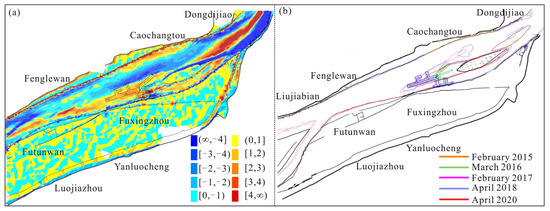
Figure 9.
Changes in riverbed scouring or deposition and continental bank morphology in the Yanziwo waterway. (a) Distribution of riverbed scouring or deposition; and (b) changes in the 0 m isobath.
4.4.2. Morphology of the Continental Bank
From February 2014 to April 2020, with the implementation of the waterway improvement project of the middle sections of the Jiayu—Yanziwo and Chibi—Panjiawan reaches (Yanziwo waterway), the low bank at the head of the heart bank (0 m line) was silted by 1200 m (from 2015 to 2018) (Figure 9b). In 2016 and 2017, the head of the heart bank and the left edge were scouring, and in central bar in the Xinzhou left branch, a shallow area of less than 4.5 m in water depth, obstructing navigation, was formed in the core of the river along the central part; dredging measures were taken to ensure a water depth of 4.2 m after the 2017 flood.
4.4.3. Impact of the Branching Channel Diversion Relationship
From 2011 to 2018 (Table 7), the diversion ratio of the northern branch of Yanziwo increased, indicating that the Yanziwo waterway improvement project efficiently regulated the diversion relationship.

Table 7.
Variation in branching ratios in the Yanziwo waterway.
Based on the analysis results, the north branch of the Yanziwo waterway increased, which is conducive to enhancing the hydrodynamic force of the main waterway. The water depth of the northern branch was greater than 4.5 m after the start of the constructed waterway improvement project, improving the waterway conditions. Deposition in the middle of the river channel at the outlet of the branch has brought potential adverse effects to the waterway, and it is difficult to achieve a long-term stable waterway scale of 4.5 × 200 m.
4.5. Obstructive Features in the Upgraded Scale of the Wuqiao Waterway
The Wuqiao waterway is slightly curved and branched. The river channel is divided into two branches by Baishazhou, of which the north one is the main branch channel. The downstream distribution of the submerged continents and the northern branch of the submerged continents are the main waterway. From 2011 to 2013, five straight groins were implemented. Since January 2019, the dry period maintenance water depth has been increasing to 4.2 m.
4.5.1. Riverbed Scouring and Deposition
From February 2014 to April 2020, the deposition thickness at the inlet of the left branch of Baishazhou was 1–2 m, the brush depth within the left branch was 2–3 m, and that within the right branch was 2–3 m (Figure 10a). The deposition of the bank body and downstream of the tail of Baishazhou, especially the deposition thickness downstream of the tail near the river channel center, was 3 m. The overall scouring of the right branch of the submerged island was 4 m at maximum brush depth.
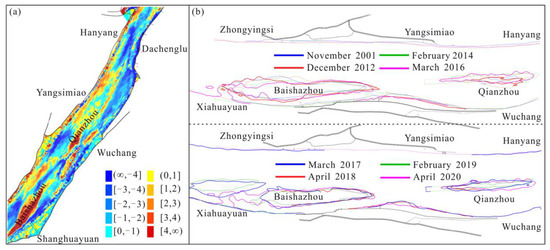
Figure 10.
Changes in riverbed scouring or continental bank morphology in the Wuqiao waterway. (a) Distribution of scouring or deposition in riverbed; and (b) changes in the 0 m isobath.
4.5.2. Morphology of the Continental Bank
From 2010 to 2012, the 0 m line at the head of Baishazhou cumulatively retreated by 500 m and turned to deposition upward by 550 m in 2014. The head of the continent has been cut into a bank since 2014, forming two bank bodies aligned above and below (Figure 9b). From April 2017 to 2020, the cut upper bank body was head-washed back to the tail of the continent, the bank body was widened to the right, and the lower bank body moved down with the upper bank body as a head washback. From March 2010 to February 2014, the 0 m line of the submerged continent extended upward by 1600 m. From February 2014 to April 2020, the extent of the 0 m line of the submerged continent changed up to 300 m along the direction of the current.
4.5.3. Impact of the Branching Channel Diversion Relationship
From 2006 to 2019, the diversion ratio of the north branch of the WCBC was 90–94% (Table 8), and the branch diversion relationship was stable under the action of the waterway improvement project, which is conducive to stable waterway conditions.

Table 8.
Variation in diversion ratios in the Baishazhou branch channel of the Wuqiao waterway.
Based on the analysis results, the Baishazhou branch channel divergence relationship is stable, which is conducive to the stability of the hydrodynamic conditions of the main waterway. The scouring of the continental body is not conducive to the stability of the river channel boundary, and the obstruction area with a water depth of less than 4.5 m appears in the left branching inlet relaxation reach.
5. Discussion and Analysis
5.1. Technical Aspects of Governance
As of December 2021, 423 waterway improvement structures were implemented along the Yangtze River mainline. For example, in the implemented waterway projects in the Jingjiang reach, Wuhan–Anqing reaches, and downstream of Nanjing, the waterway water depth has been raised from 3.2 to 3.8 m, 4.5 to 6.0 m, and 10.5 to 12.5 m, respectively, resulting in a mature waterway management technology [25]). Since 1994, seven waterway improvement projects have been implemented in the Chenglingji—Wuhan reaches of the middle section of the Yangtze River (Figure 5, Table 9), with a waterway bathymetry target of 3.7 m. Waterway improvement projects were implemented, and the overall scouring caused by the reduction of incoming sediment was raised to a maintenance bathymetry of 4.2 m in February 2021 in the Chenglingji—Wuhan reaches [26].

Table 9.
Implemented waterway improvement project works in the Chenglingji—Wuhan reaches.
With a water depth of 4.5 m as the target, the water depth was raised from 4.2 to 4.5 m, which is smaller than the raising rate of the implemented waterway improvement project in the middle-lower sections of the Yangtze River. Additionally, it is technically feasible to raise the water depth of Chenglingji—Wuhan reaches to 4.5 m.
5.2. Ecological Aspects
The Lipotes Vexillifer National Nature Reserve in the Xin–Luo reaches of the Yangtze River stretches from Luoshan to Xintankou and mainly protects the Baiji dolphin, finless porpoises, and their habitat. The reserve is included in the Hubei ecological protection red line, and 11 waterways in the Chenglingji—Wuhan reaches from Jiepai to Baishazhou are located in the reserve (Figure 11), including the Bailuoji, Jiepai, Luxikou, Jiayu, and Wuqiao waterways. According to the relevant requirements of the Chinese government for ecological protection zones, anthropogenic activities are prohibited in the core protection zones of nature reserves. Developmental and productive construction activities are strictly prohibited in other areas, and only limited anthropogenic activities that do not cause damage to ecological functions are allowed under the premise of complying with existing laws and regulations, with the exception of major national strategic projects. However, many ecological structures and new materials have been used in waterway improvement projects along the Yangtze River mainline, producing better ecological effects [27,28]. To protect the ecological environment as well as to minimize the impact on the water ecology, although there are 17 Class I water resources protection zones distributed in the Chenglingji—Wuhan reaches, it is not recommended to implement the waterway improvement project to upgrade the scale of the channel in view of the ecological sensitivity and impact. Waterway improvement projects have been systematically implemented on the Yangtze River trunk line using various environmentally friendly structures, including tetrahedral frames [29,30], dolosse [31], W-shaped dams [32], ‘fish tank’ bricks [31,33], D- and X-shaped rows, and grass-planting and sand-fixing structures [34,35]. A large number of ecological bank protection structures [36] and groin dam structures [37] have also been developed internationally, which have been applied in river management projects such as the Mississippi River [38,39] and the Rhine River [40]. According to long-term observations since 2013, these structures have had a significant positive effect on the ecological environment of the Yangtze River [41,42,43]. Onsite monitoring results have revealed that after the implementation of the first-phase project of the Jingjiang reach, vegetation in the high bank increased considerably. For example, the Daokoujiao central bar has gradually transformed from a bear bank into a lush-vegetation area [34], and the growth of vegetation effectively stabilized the bank. Fish abundance near the constructions has also increased, and benthos has been recovered [44,45]. The ecological restoration measures adopted by the waterway improvement project with a 12.5 m depth downstream of Nanjing, including artificial fish nests and ecological floating beds, have had significant effects because the floating bed plants have been growing significantly and the number of plankton in fish nests has been increasing [46]. In the planning of waterway improvement projects to increase the Chenglingji—Wuhan reaches waterway water depth to 4.5 m, considering novel environment-friendly waterway regulating structures is vital to ensure that the ecological environment of the Chenglingji—Wuhan reaches benefits from the projects.
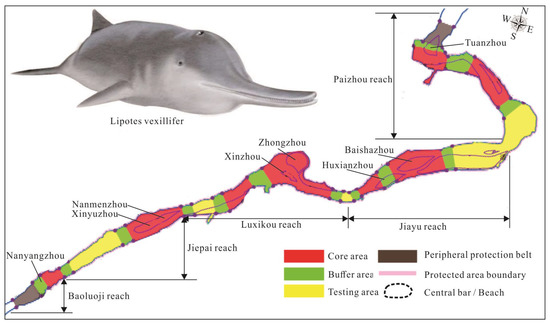
Figure 11.
The Lipotes Vexillifer National Nature Reserve in the Xin—Luo reaches of the Yangtze River.
5.3. Dredging Maintenance Aspects
Dredging maintenance can directly improve the waterway bathymetry [47,48], and although there is the issue of large deposition return rate after dredging [10,13], its ecological impact can be minimized. In response to the current condition of the 4.2 m maintenance water depth, dredging measures have been taken since 2018 in the Jiebei, Jiayu, and Yanziwo waterways. Overall, 98 × 104 m3 and 38 × 104 m3 were dredged in 2019 and 2020 for the Jiebei waterway; areas of 70 × 104 m3, 78 × 104 m3, 27 × 104 m3, and 66 × 104 m3 were dredged. For the 4.5 m × 200 m waterway scale, the annual dredging volume of the Chenglingji—Wuhan reaches is 150–200 × 104 m3, which is slightly larger than the 4.2 m water depth conditions in 2019 (125 × 104 m3) and 2020 (104 × 104 m3). In the past 20 years, immense experience has been accumulated regarding the use of dredged spoils in the Yangtze River mainline waterway [49] and ecological protection during dredging [50,51], and a 12.5 m water depth penetration downstream of Nanjing in the Yangtze River has been achieved through the combination of waterway improvement works and waterway dredging [10,13]. In the United States, dredging measures have effectively improved the waterway scale [48]. With the combination of the waterway improvement project and dredging measures, the Yangtze River Estuary has fully penetrated the 12.5 m deep-water waterway [52] and gradually extended to Nanjing city [10]. In the middle reaches of the Yangtze River that have serious obstructions to navigation, due to the implementation of waterway dredging measures, the waterway scale meets the planning requirements [19,53]. On the whole, dredging is one of the necessary means to realize the integration of the improvement scale.
The operation of the Three Gorges Dam and the upstream cascade reservoir has significantly reduced the sediment volume in the middle-lower sections of the Yangtze River and caused cumulative scouring in the middle-lower sections of the Yangtze River [6,9,53,54,55]. For a period of time in the future, the amount of sediment in the middle-lower sections of the Yangtze River will remain at a low level [56,57,58], and the continuous erosion will bring favorable conditions for the stability and improvement of waterway water depth. It is technically feasible to increase the water depth of the Chenglingji—Wuhan reaches of the waterway from 4.2 to 4.5 m through waterway improvement engineering measures. Considering the impacts on the ecological environment protection zone and water quality resource protection zone, it is recommended to achieve a 4.5 m × 60 m, 4.5 m × 150 m, and 4.5 m × 200 m waterway scale in the Chenglingji—Wuhan reaches through dredging.
5.4. Runoff and Sediment Conditions
Under the comprehensive influence of the joint operation of the Three Gorges and the upstream cascade reservoir group and soil and water conservation, the sediment flow into the middle and lower sections of the Yangtze River has been significantly reduced [6,7], and the riverbed is in a significant scouring situation [6,7,54,55,56], and this trend has been extended to the Yangtze River Estuary [10,58]. Riverbed scouring has brought favorable conditions for the enhancement of waterway scale. Under the action of channel regulation engineering and river regime control engineering, the waterway scale of the Yangtze River Basin has been significantly improved [11,17,19]. With the increase in reservoir capacity in the upper section of the Yangtze River, the amount of sediment entering the middle-lower sections will remain at a low level or decrease in the future, and the scouring situation of the riverbed will continue [6,9,54]. At the same time, the south bank of the Jingjiang reaches into Dongting Lake through three diverts, and Chenglingji (Yueyang City) rejoins the Yangtze River, forming a complex river–lake material exchange system [20,55,59,60,61,62,63]. Compared with 1954–2002, the runoff of Luoshan hydrographic station from 2003 to 2021 was 6460 × 108 m3 and 6255 × 108 m3, with a decrease of 2.86%, and the sediment volume was 4.09 × 108 t and 0.83 × 108 t, respectively. The reduction is 79.71% (Figure 12a). From 2003 to 2021, the runoff of Chenglingji hydrographic station was 2930 × 108 m3 and 2492 × 108 m3, respectively, with a decrease of 14.95%, and the sediment volume was 0.418 × 108 t and 0.174 × 108 t, respectively. The reduction was 58.37% (Figure 12b). From 1954 to 2002, the proportions of runoff and sediment transport from Dongting Lake into the Yangtze River at Luoshan hydrographic station were 45.36% and 39.84%, respectively, and during 2003–2021, they were 10.22% and 20.96% (Figure 11). From 2003 to 2021, the proportion of runoff of Dongting Lake into the Yangtze River decreased, while the proportion of sediment increased, that is, the influence of Dongting Lake into the Yangtze River on the Chenglingji—Wuhan reaches was strengthened. In the future, although the sediment inflow in the basin will remain at a low level or decrease, it is still necessary to pay attention to the influence of the change in the relationship between Dongting Lake and the Yangtze River trunk on the waterway conditions.
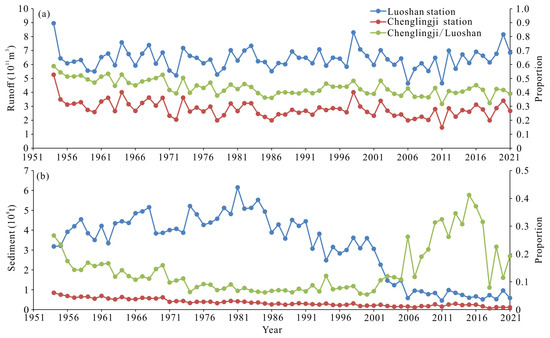
Figure 12.
The runoff–sediment relationship between the Yangtze River and Dongting Lake. (a) The relationship between runoff; (b) relation of sediment transport.
In terms of waterway management, dredging, and maintenance technology, it is feasible to increase the waterway scale of Chenglingji—Wuhan reaches to 4.5 m × 200 m. Although some waterway regulation projects may be in the ecological protection zone, ecological protection measures can be adopted to reduce the impact on the ecological environment.
6. Conclusions
In this study, we analyzed the relationship between the changes in riverbed deposition, continental bank morphology, branch channel divergence, and the degree of obstruction to navigation considering depths from 4.2 to 4.5 m. We also explored the countermeasures for waterway scale enhancement in terms of waterway management technology, ecological environmental protection, and dredging maintenance in the middle section of the Yangtze River.
- (1)
- After the start of the Three Gorges Project, the decrease in sediment inflow caused a scouring situation in the Chenglingji—Wuhan reaches of the Yangtze River, and 94.95% of the scouring was concentrated in the low-flow channel, which created a favorable foundation for the improvement of waterway water depth.
- (2)
- Considering the connection between the water depth of the upstream and downstream waterways, the representative ship type, and navigable width and other factors, waterway scale verification was conducted with 4.5 m × 200 m, 4.5 m × 150 m, and 4.5 m × 60 m. Only five waterways failed to meet the planning scale, and the length of obstructed navigation accounted for 2% in the total length of the reach.
- (3)
- Under the combined effect of waterway engineering and riverbed scouring, the waterway water depth for the Chenglingji—Wuhan reaches has been raised from 2.9 m in 2003 to 4.2 m, and it is technically feasible to raise the water depth to 4.5 m through waterway regulation. It is beneficial to explore dredging and maintenance measures to protect the ecological environment.
Author Contributions
Conceptualization, Y.Y., X.Z. and M.Z.; methodology, Y.Y.; software, Y.Y.; validation, M.Z.; formal analysis, J.W.; investigation, W.X.; resources, W.X.; data curation, Y.Y.; writing—original draft preparation, W.X.; writing—review and editing, Y.Y.; visualization, Y.Y.; supervision, M.L.; project administration, M.L.; funding acquisition, Y.Y. All authors have read and agreed to the published version of the manuscript.
Funding
This study was funded by the Fundamental Research Funds for Central Welfare Research Institutes (TKS20230105); National Natural Science Foundation of China (52279066; 51979132); Special Scientific Research Project of Changjiang Waterway Regulation (SXHXGZ-2022-1); and Science and Technology project of Hubei Provincial Department of Transport (2022-175). The hydrological data for this study were provided by the Bureau of Hydrology, Changjiang Water Resources Commission, and the Changjiang Waterway Bureau. The contributions of other organizations and individuals involved are gratefully acknowledged.
Data Availability Statement
The data presented in this study are available on request from the corresponding author.
Conflicts of Interest
The authors declare no conflict of interest.
References
- Dang, M.H.; Umeda, S.; Yuhi, M. Long-term riverbed response of lower Tedori River, Japan, to sediment extraction and dam construction. Environ. Earth Sci. 2014, 72, 2971–2983. [Google Scholar] [CrossRef]
- Moretto, J.; Rigon, E.; Mao, L.; Picco, L.; Delai, F.; Lenzi, M.A. Channel adjustments and island dynamics in the Brenta River (Italy) over the last 30 years. River Res. Appl. 2014, 30, 719–732. [Google Scholar] [CrossRef]
- Wang, S.; Fu, B.J.; Piao, S.L.; Lü, Y.; Ciais, P.; Feng, X.; Wang, Y.C. Reduced sediment transport in the Yellow River due to anthropogenic changes. Nat. Geosci. 2016, 9, 38–41. [Google Scholar] [CrossRef]
- Smith, N.D.; Morozova, G.S.; Pérez-Arlucea, M.; Gibling, M.R. Dam-induced and natural channel changes in the Saskatchewan River below the E.B. Campbell Dam, Canada. Geomorphology 2016, 269, 186–202. [Google Scholar] [CrossRef]
- Yang, Y.P.; Zhang, M.J.; Zhu, L.L.; Liu, W.L.; Han, J.Q.; Yang, Y.H. Influence of Large Reservoir Operation on Water-Levels and Flows in Reaches below Dam: Case Study of the Three Gorges Reservoir. Sci. Rep. 2017, 7, 15640. [Google Scholar] [CrossRef]
- Yang, Y.P.; Zheng, J.H.; Zhang, H.Q.; Chai, Y.F.; Zhu, Y.D.; Wang, C.Y. Impact of the Three Gorges Dam on riverbed scour and siltation of the middle reaches of the Yangtze River. Earth Surf. Process. Landf. 2022, 47, 1514–1531. [Google Scholar] [CrossRef]
- Yang, Y.P.; Zheng, J.H.; Zhang, M.J.; Zhu, L.L.; Zhu, Y.D.; Wang, J.J.; Zhao, W.Y. Sandy riverbed shoal under anthropogenic activities: The sandy reach of the Yangtze River, China. J. Hydrol. 2021, 603, 126861. [Google Scholar] [CrossRef]
- Zhao, W.Y.; Yang, Y.P.; Zhang, H.Q.; Zhang, M.J.; Yuan, J.; Yang, B.C. Adjustment patterns and causes of the morphology of sandy riverbed downstream of the Three Gorges Dam. Adv. Water Sci. 2020, 31, 862–874. (In Chinese) [Google Scholar]
- Li, S.X.; Yang, Y.P.; Zhang, H.Q.; Zhu, L.L.; Zhu, Y.D.; Zhang, M.J. The scouring and siltation in river channels of the middle reaches of the Yangtze River (1975-2017) before/after the Three Gorges Project. J. Lake Sci. 2021, 33, 1520–1531. (In Chinese) [Google Scholar]
- Yang, Y.P.; Zheng, J.H.; Zhang, W.; Zhu, Y.D.; Chai, Y.F.; Wang, J.J.; Wen, Y.C. Quantitative relationship between channels and bars in a tidal reach of the lower Yangtze River: Implications for river management. J. Geogr. Sci. 2021, 31, 1837–1851. [Google Scholar] [CrossRef]
- Yang, Y.P.; Zhang, M.J.; Liu, W.L.; Wang, J.J.; Li, X.X. Relationship between Waterway Depth and Low-Flow Water Levels in Reaches below the Three Gorges Dam. J. Waterw. Port Coast. Ocean Eng. 2019, 145, 04018032. [Google Scholar] [CrossRef]
- Peng, S.B.; Huang, C.T.; Jiang, L. Feasibility study on waterway scale upgrading of Yangtze River stem from Yichang to Anqing. Yangtze River 2017, 48, 1–4. (In Chinese) [Google Scholar]
- Wang, J.J.; Yang, Y.P.; Shen, X.; Ying, H.H.; Qiao, H.Q. Study on the Deformation of the Point/Channel Bar of the Variable Section of the Tidal Current Limit of Yangtze River and Its Influence on the Scouring and Silting of Dredged Channel. J. Basic Sci. Eng. 2020, 28, 751–762. (In Chinese) [Google Scholar]
- Cao, F.S.; Xiao, X.; Wu, P. Yangtze River: China’s golden waterway. Civil Eng. 2010, 163, 15–18. [Google Scholar]
- Wang, Y.C.; Chen, X.B.; Borthwick, A.G.L.; Li, T.H.; Liu, H.H.; Yang, S.F.; Zheng, C.M.; Xu, J.H.; Ni, J.R. Sustainability of global Golden Inland Waterways. Nat. Commun. 2020, 11, 1553. [Google Scholar] [CrossRef] [PubMed]
- Ministry of Transport of the People’s Republic of China (MOT). The Development of Waterway Transportation Market in 2021 and the Market Prospect in 2022 [EB/OL]; Ministry of Transport of the People’s Republic of China: Beijing, China, 2022. (In Chinese)
- Yang, Y.P.; Zhang, M.J.; Sun, Z.H.; Han, J.Q.; Wang, J.J. The relationship between water level change and river channel geometry adjustment in the downstream of the Three Gorges Dam. J. Geogr. Sci. 2018, 28, 1975–1993. [Google Scholar]
- Li, M.; Hu, C.H.; Zhou, C.C.; Peng, S.B. Analysis on the Evolution mechanism of the “steep slope and rapid flow” section of Lujia waterway in the middle reaches of the Yangtze River under new conditions of water and sediment. J. Hydraul. Eng. 2021, 52, 158–168. [Google Scholar]
- Yang, Y.P.; Li, M.; Liu, W.L.; Zhu, Y.D.; Yang, L.J.; Yu, W.J. Study on the relationship between beach trough evolution and navigation obstruction characteristics in Jingjiang reach of the Yangtze River. Adv. Water Sci. 2022, 33, 240–252. (In Chinese) [Google Scholar]
- Yang, Y.P.; Liu, W.L.; Zhang, J.; Yang, L.J.; Jia, M.L.; Zhu, L.L. Changes of Divergence and Confluence Relationship Between Dongting Lake and the Yangtze River After the Operation of the Three Gorges Project and Its Impact on the Waterway Depth. Front. Earth Sci. 2022, 10, 829669. [Google Scholar] [CrossRef]
- National Development and Reform Commission of the People’s Republic of China (NDRC). Development Plan of ‘14th Five-Year’ Modern Comprehensive Transportation System [EB/OL]; National Development and Reform Commission of the People’s Republic of China: Beijing, China, 2022. (In Chinese)
- You, X.Y.; Tang, J.W.; Zhang, X.F.; Yang, Y.P.; Weng, Z.H.; Sun, Z.H. Mechanism of barrier river reaches in the middle and lower reaches of the Yangtze River. Acta Geogr. Sin. 2017, 72, 817–829. (In Chinese) [Google Scholar] [CrossRef]
- You, X.Y.; Tang, J.W.; Zhang, X.F.; Hou, W.G.; Yang, Y.P.; Sun, Z.H.; Wen, Z.H. The mechanism of barrier river reaches in the middle and lower Yangtze River. J. Geogr. Sci. 2017, 27, 1249–1267. [Google Scholar] [CrossRef]
- Liu, L.; Huang, C.T.; Li, M.; Zhang, M. Periodic Evolution Mechanism of Staggered Beach in Typical Straight Reach of the Middle Yangtze River. J. Basic Sci. Eng. 2014, 22, 445–456. (In Chinese) [Google Scholar]
- Liu, H.H.; Yang, S.F.; Cao, M.X. Advances in ‘Golden Waterway’ Regulation Technologies of the Yangtze River. Adv. Eng. Sci. 2017, 49, 17–27. (In Chinese) [Google Scholar]
- Changjiang Waterway Bureau (CWB). Planned Scales of Yangtze River Waterway Maintenance in 2021 [EB/OL]; Changjiang Waterway Bureau: Beijing, China, 2021. (In Chinese) [Google Scholar]
- Chen, Y.R. Practice and Reflection on Green Waterway Construction on Jingjiang River Section in the Middle Reaches of Yangtze River. Technol. Econ. Changjiang 2021, 5, 51–53. (In Chinese) [Google Scholar]
- Li, T.H.; Ding, Y.; Xia, W. An integrated method for waterway health assessment: A case in the Jingjiang reach of the Yangtze River, China. Phys. Geogr. 2018, 39, 67–83. [Google Scholar] [CrossRef]
- Wang, K.; Guo, J.; Duan, X.B.; Chen, D.Q.; Liu, S.P. Preliminary evaluation on fish-aggregation effects of tetrahedron-like penetrating frame structure in Jingjiang channel regulation project. Freshw. Fish. 2017, 47, 97–104. (In Chinese) [Google Scholar]
- Xing, Y.; Lv, B.; Ma, D.G.; Zhang, H.Q.; Yu, G.N. Hydrodynamic modeling to evaluate the influence of inland navigation channel training works on fish habitats in the Upper Yellow River. Ecol. Eng. 2021, 169, 106289. [Google Scholar] [CrossRef]
- Cao, M.X.; Shen, X.; Huang, Z.B.; Luo, H.W.; Ying, H.H.; Lin, W. Techniques of ecological and protection based on deepwater navigation channel project in the Yangtze River below Nanjing. Port Waterw. Eng. 2018, 544, 1–9. (In Chinese) [Google Scholar]
- Huang, T.J.; Lu, Y.; Liu, H.X. Effects of spur dikes on water flow diversity and fish aggregation. Water 2019, 11, 1822. [Google Scholar] [CrossRef]
- Wang, X.; Huang, W.; Lu, J.T.; Luo, H.W.; Fan, J.; Wang, Q.Q.; Cao, Z.H. Ecological protection measures and effects of channel regulation in Jingjiang River section. China Harb. Eng. 2020, 40, 1–4. (In Chinese) [Google Scholar]
- Li, M. Research on the ecological shoal consolidation methods in river central bar protection: Taking the implantable ecological shoal consolidation engineering in Yangtze River Daokouyao Channel Bar as on example. China Rural Water Hydropower 2018, 7, 78–83. (In Chinese) [Google Scholar]
- Fan, Y.J.; Yang, Z.H.; Zou, M.Z.; Li, M.; Zhang, Z.Y.; Li, D.; Liu, J.H.; Liu, Q. Evaluation of ecological effect of steel wire mesh stone cage revetment in middle and lower reaches of the Yangtze River. Port Waterw. Eng. 2020, 578, 129–135. [Google Scholar]
- Najafzadeh, M.; Oliveto, G. Riprap incipient motion for overtopping flows with machine learning models. J. Hydroinf. 2020, 22, 749–767. [Google Scholar] [CrossRef]
- Wang, P.Y.; Tian, Y.; Wang, M.L.; Guo, G.T. Service Life Prediction of Flexible Concrete Mattresses (FCMs) in the Yangtze River. Sustainability 2023, 15, 3496. [Google Scholar] [CrossRef]
- Bart, H.L.; Martinat, P.J.; Abdelghani, A.; Tchounwou, P.B.; Taylor, S.L. Influence of taxonomy, ecology, and seasonality in river stage fish contamination risks in floodplain swamps of the lower Mississippi river. Ecotoxicology 1998, 7, 325–334. [Google Scholar]
- Altenritter, M.E.; Pescitelli, S.M.; Whitten, A.L.; Casper, A.F. Implications of an invasive fish barrier for the long-term recovery of native fish assemblages in a previously degraded northeastern Illinois River system. River Res. Appl. 2019, 35, 1044–1052. [Google Scholar] [CrossRef]
- Fu, G. Experience of estuary channel regulation at home and abroad and enlightenment for regulation of the Yangtze Estuary channel. Port Waterw. Eng. 2016, 522, 121–128. (In Chinese) [Google Scholar]
- Li, T.H.; Ding, Y.; Ni, J.R.; Xia, W. Ecological Waterway Assessment of the Jingjiang River Reach. J. Basic Sci. Eng. 2017, 25, 221–234. (In Chinese) [Google Scholar]
- Liu, N.; Li, T.H.; Xi, H.J. River Ecosystem Value Changes on Jingjiang Reach of the Yangtze River. J. Basic Sci. Eng. 2021, 29, 1335–1346. (In Chinese) [Google Scholar]
- Yin, S.R.; Yang, Y.P.; Wang, J.J.; Zhang, J.; Cai, Q.H.; Zhu, Y.D.; Wang, C.Y. Simulating Ecological Effects of a Waterway Project in the Middle Reaches of the Yangtze River Based on Hydraulic Indicators on the Spawning Habitats of Four Major Chinese Carp Species. Water 2022, 14, 2147. [Google Scholar] [CrossRef]
- Liu, H.H.; Lei, G.P.; Yin, S.R.; Kuang, H.W. Ecological measures and technology prospect for trunk waterway management in the Yangtze River. Port Waterw. Eng. 2016, 511, 114–118. (In Chinese) [Google Scholar]
- Liu, N.; Li, T.H.; Kuang, S.Y. Ecological waterway assessment of Wuhan-Anqing reach of the Yangtze River. Acta Sci. Nat. Univ. Pekin. 2021, 57, 489–495. (In Chinese) [Google Scholar]
- Barbe, D.E.; Fagot, K.; McCorquodale, J.A. Effects on dredging due to diversions from the lower Mississippi River. J. Waterw. Port Coast. Ocean Eng. 2000, 126, 121–129. [Google Scholar] [CrossRef]
- Zeng, L.; Wu, W.G.; Cai, H. Deep-water channel maintenance characteristics of Fujiangsha waterway in lower reaches of the Yangtze River. Port Waterw. Eng. 2022, 603, 181–184. (In Chinese) [Google Scholar]
- McAnally, W.H.; Kirby, R.; Hodge, S.H.; Welp, T.L.; Greiser, N.; Shrestha, P.; McGowan, D.; Turnipseed, P. Nautical Depth for U.S. Navigable Waterways: A Review. J. Waterw. Port Coast. Ocean Eng. 2015, 142, 04015014. [Google Scholar] [CrossRef]
- Zhou, C.C.; Li, M. Ecological channel construction technology combining ecological beach consolidation and ecological utilization of dredged spoil. Port Waterw. Eng. 2020, 572, 141–145. (In Chinese) [Google Scholar]
- Hu, P.; Deng, S.Y.; Zhao, Z.X.; Cao, Z.X.; Liu, H.H. Dredging Volume Estimation and Dredging Timing for Waterway Maintenance: A Case Study Using a Depth-Averaged Hydrosediment-Morphodynamic Model with Transient Dredging Effects. J. Waterw. Port Coast. Ocean Eng. 2022, 148, 04022014. [Google Scholar] [CrossRef]
- Hu, P.; Deng, S.Y.; Zhao, Z.X.; Cao, Z.X.; Liu, H.H.; He, Z.G. Hydro-sediment-morphodynamic modeling of riverbed evolution and calculation of dredging volume. J. Zhejiang Univ. 2021, 55, 733–741. (In Chinese) [Google Scholar]
- Liu, J.; Cheng, H.F.; Han, L.; Wang, Z.Z. Interannual variations on siltation of the 12.5 m deepwater navigation channel in Yangtze Estuary. Adv. Water Sci. 2019, 30, 65–75. (In Chinese) [Google Scholar]
- Yang, Y.P.; Li, M.; Liu, W.L.; Chai, Y.F.; Zhang, J.; Yu, W.J. Relationship between potential waterway depth improvement and evolution of the Jingjiang Reach of the Yangtze River in China. J. Geogr. Sci. 2023, 33, 547–575. [Google Scholar] [CrossRef]
- Yang, Y.P.; Zhou, L.P.; Zhu, L.L.; Liu, W.L.; Wang, J.J. Impact of upstream reservoirs on geomorphic evolution in the middle and lower reaches of the Yangtze River. Earth Surf. Process. Landf. 2022, 48, 582–595. [Google Scholar] [CrossRef]
- Yang, Y.P.; Yin, H.; Li, M.; Liu, W.L.; Li, K.Y.; Yu, W.J. Effect of water depth and waterway obstructions on the divergence and confluence areas of Dongting Lake and the Yangtze River after the operation of the Three Gorges Project. River 2023, 2, 88–108. [Google Scholar] [CrossRef]
- Yang, Y.P.; Zheng, J.H.; Zhu, L.L.; Zhang, H.Q.; Wang, J.J. Influence of the Three Gorges Dam on the transport and sorting of coarse and fine sediments downstream of the dam. J. Hydrol. 2022, 615, 128654. [Google Scholar] [CrossRef]
- Zhang, W.; Yang, Y.P.; Zhang, M.J.; Li, Y.T.; Zhu, L.L.; You, X.Y.; Wang, D.; Xu, J.F. Mechanisms of suspended sediment restoration and bed level compensation in downstream reaches of the Three Gorges Projects (TGP). J. Geogr. Sci. 2017, 27, 463–480. [Google Scholar] [CrossRef]
- Wang, J.J.; Yang, Y.Y.; Zhang, M.J.; Zhu, L.L.; Li, S.W.; Wen, Y.C. Critical threshold of periodic point bar scour and sediment body transport path in tidal reaches: A case study of Fujiangsha reach, Yangtze River. J. Geogr. Sci. 2023, 33, 1334–1358. [Google Scholar]
- Lou, Y.Y.; Dai, Z.J.; Lu, X.X.; Li, D.F. Anthropogenic pressures induced hydromorphodynamic changes of riverine islands in the Upper Jingjiang reach along the Changjiang (Yangtze) River. Catena 2022, 217, 106488. [Google Scholar] [CrossRef]
- Yu, Y.W.; Mei, X.F.; Dai, Z.J.; Gao, J.J.; Li, J.B.; Wang, J.; Lou, Y.Y. Hydromorphological processes of Dongting Lake in China between 1951 and 2014. J. Hydrol. 2018, 562, 254–266. [Google Scholar] [CrossRef]
- Hu, Y.; Deng, J.Y.; Li, Y.T.; Liu, C.C.; He, Z.C. Flow resistance adjustments of channel and bars in the middle reaches of the Yangtze River in response to the operation of the Three Gorges Dam. J. Geogr. Sci. 2022, 32, 2013–2035. [Google Scholar] [CrossRef]
- Hu, Y.; Li, D.F.; Deng, J.Y.; Yue, Y.; Zhou, J.X.; Chai, Y.F.; Li, Y.T. Mechanisms Controlling Water-Level Variations in the Middle Yangtze River Following the Operation of the Three Gorges Dam. Water Resour. Res. 2022, 58, e2022WR032338. [Google Scholar] [CrossRef]
- Yang, Y.P.; Zhang, M.J.; Zhu, L.L.; Zhang, H.Q.; Liu, W.L.; Wang, J.J. Impact of the operation of a large-scale reservoir on downstream river channel geomorphic adjustments: A case study of the Three Gorges. River Res. Appl. 2018, 34, 1315–1327. [Google Scholar] [CrossRef]
Disclaimer/Publisher’s Note: The statements, opinions and data contained in all publications are solely those of the individual author(s) and contributor(s) and not of MDPI and/or the editor(s). MDPI and/or the editor(s) disclaim responsibility for any injury to people or property resulting from any ideas, methods, instructions or products referred to in the content. |
© 2023 by the authors. Licensee MDPI, Basel, Switzerland. This article is an open access article distributed under the terms and conditions of the Creative Commons Attribution (CC BY) license (https://creativecommons.org/licenses/by/4.0/).